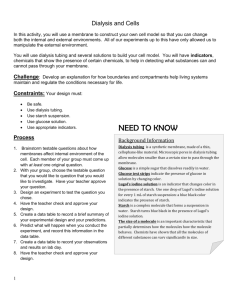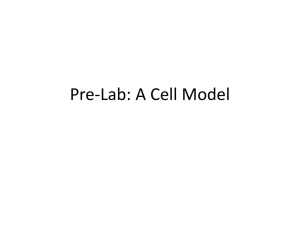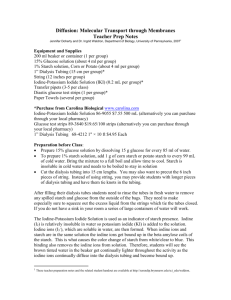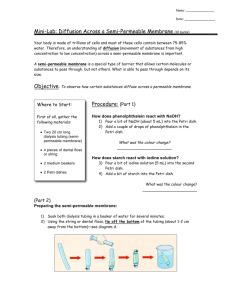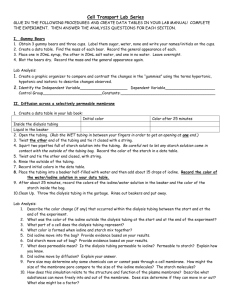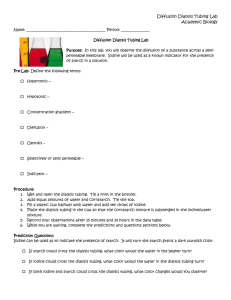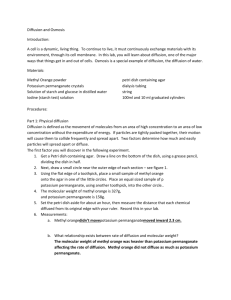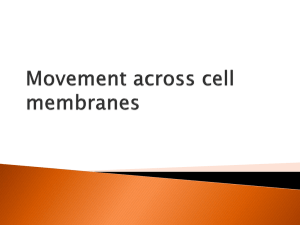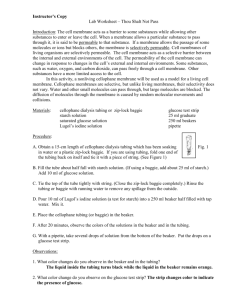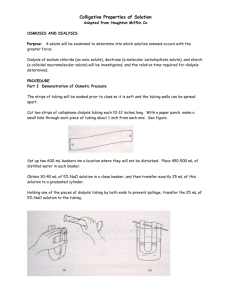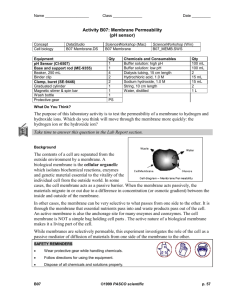Patterns in Nature Topic Test Answers - aiss-biology-11
advertisement
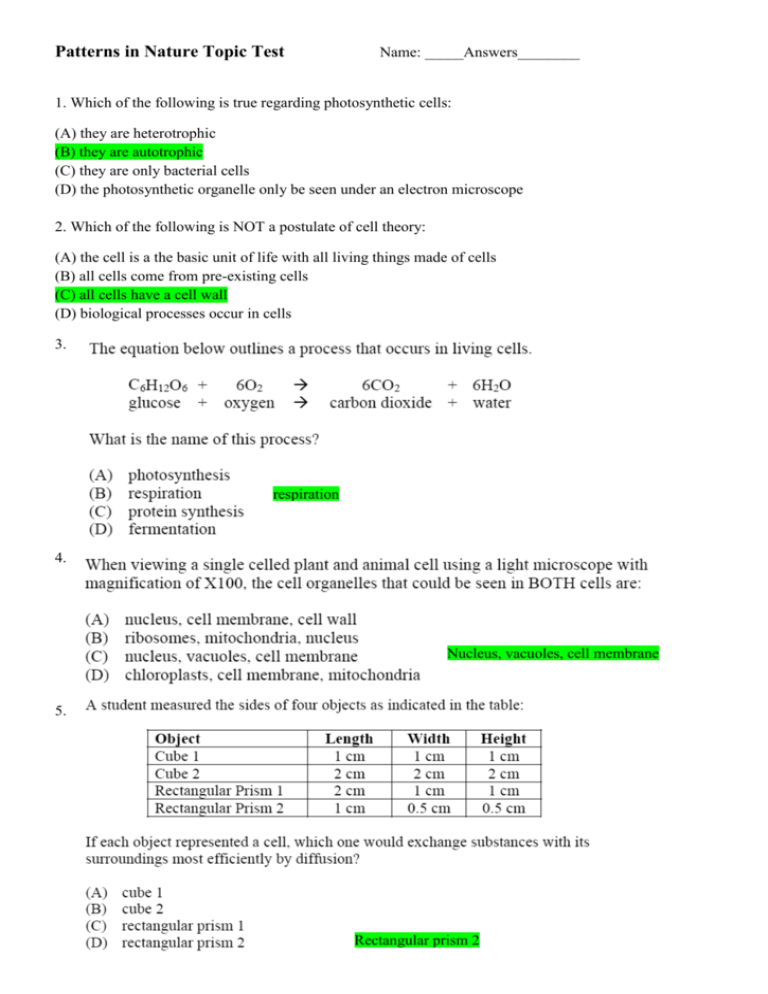
Patterns in Nature Topic Test Name: _____Answers________ 1. Which of the following is true regarding photosynthetic cells: (A) they are heterotrophic (B) they are autotrophic (C) they are only bacterial cells (D) the photosynthetic organelle only be seen under an electron microscope 2. Which of the following is NOT a postulate of cell theory: (A) the cell is a the basic unit of life with all living things made of cells (B) all cells come from pre-existing cells (C) all cells have a cell wall (D) biological processes occur in cells 3. respiration 4. Nucleus, vacuoles, cell membrane 5. Rectangular prism 2 6. herbivore 7. Transpiration, photosynthesis and respiration 8. Prokaryotic and autotrophic 9. They attract birds and… 10. A student performed a test to demonstrate that photosynthesis was dependent on sunlight. Which of the following is true regarding their experiment? (A) The left half the leaf was covered in aluminium foil to block sunlight for several days. (B) The leaf was treated with starch after being removed from the plant. (C) The cell walls of the leaf were degraded with an ice cold solution of ethanol. (D) The blue-black colour in half of the leaf was the result of staining with iodine solution. 11. Which of the following is true regarding diagrams A and B, which represent the digestive systems of two vertebrates? A B (A) Vertebrate A is a herbivore and vertebrate B is a carnivore. (B) As plant fibre is hard to digest, a herbivorous vertebrate has a longer and more complex digestive tract than a carnivore. (C) Vertebrate A could be a dingo and vertebrate B could be a koala. (D) Both B & C are true. 12. Which of the following correctly states terms relating to a cell type, tissue, organ and an organ system of a plant, in that order? (A) Mesophyll, photosynthetic, leaf, vascular (B) Epithelial, reproductive, meristematic, root (C) Photosynthetic, phloem companion, vascular, mesophyll (D) Reproductive, epithelial, root, mesophyll 13. A food technologist performed the following tests on a range of foods to determine the nutrients present in the foods. Which of the following correctly states the positive test results for glucose or for lignin? (A) Glucose = pale blue solution turns reddish-purple. (B) Glucose = pale blue solution turns orange-red. (C) Lignin = stains orange-red. (D) Lignin = stains blue-black. 14. Cells contain numerous organelles. Which of the following statements are correct relating to the nucleus and ribosomes? (A) The nucleus contains deoxyribonucleic acid (DNA). (B) The DNA contains genes which code for a particular protein (polypeptide). (C) Ribosomes are where proteins (polypeptides) are synthesised. (D) All of the above. 15. Which of the following statements are correct regarding open and closed circulatory systems? (A) An advantage of a closed circulatory system is that the circulatory fluid and the interstitial fluid are separate, so each has particular properties (eg. the haemoglobin in red blood cells has high oxygen carrying capacity). (B) An advantage of an open circulatory system is that it requires less energy to push haemolymph around the body. (C) A disadvantage of an open circulatory system is that it cannot carry as much oxygen as blood can. (D) All of the above. 16 2 marks Equipment: Dialysis tubing, starch solution, iodine solution, beaker, retort stand Method: 1. Tie dialysis tubing at bottom end. 2. Fill dialysis tubing ~5cm high with starch solution. 3. Half fill a beaker with iodine solution. 4. Hang starch solution-filled dialysis tubing from retort stand into the beaker of iodine solution, so that about half the starch solution is submerged in the iodine solution. 5. Observe the following day. *** (It`s always good to draw a labelled diagram of the set-up). (1 mark) Results: The clear starch solution that was in the dialysis tubing turned a blue-black colour. As iodine stains starch a blue-black colour, this demonstrates that the iodine was able to diffuse across the dialysis tubing membrane, into the dialysis tubing. The original colour of the solution in the beaker was a pale yellow colour due to the iodine. As the solution in the beaker did not turn blue-black, it demonstrates that the starch molecules were not able to diffuse across the dialysis tubing membrane. The results therefore indicate that the membrane of dialysis tubing is selectively permeable; it is permeable to iodine, but not to starch. (1 mark) 1 mark Osmosis is the diffusion of water across a selectively permeable membrane from an area of high water concentration to an area of low water concentration. For example, if a solution outside a cell is hypertonic to the cell (that is, if there is a greater concentration of solute in the solution than in the cell and therefore the concentration of the water is lower in the solution than in the cell) the water will diffuse down the concentration gradient, across the cell membrane to the solution outside the cell. (***A labelled diagram could help you to explain this after giving the definition) 1 mark It was observed that the volume of the iodine solution in the beaker decreased, while the volume of the solution in the dialysis tubing increased (it had become very turgid overnight). As the iodine molecules were small enough to diffuse across the membrane, equilibrium relative to iodine could be reached. However, as the starch molecules were too large to diffuse across the membrane, the solution in the dialysis tubing was hypertonic to the solution in the beaker in relation to starch molecules. This caused the water molecules to diffuse down their concentration gradient, into the dialysis tubing, causing the observed swelling of the tubing due to the increased volume of water in it due to osmosis. 1 mark An implication of these results indicate that the cell membrane of organisms is selectively permeable to some substances (eg water) but not to others (eg starch). This means that the cell is able to obtain and excrete water as required, relative to concentrations of solutes both in and outside of the cell, thereby maintaining water balance. This would be ideal in isotonic conditions. A disadvantage of this would be when the conditions outside the cell become too hypertonic or hypotonic, causing the cell to either become flaccid or turgid (possibly bursting) respectively. It also means that as the cell membrane is not permeable to all substances, that passive diffusion of substances is not adequate for the case of all substances required by the cell, and the cell must therefore have mechanisms by which active transport can take place, so that substances may be obtained or excreted against the concentration gradient. 17 1 mark Transpiration is the evaporation of water from plants. It primarily occurs at the leaves while their stomata are open for the passage of CO2 and O2 during photosynthesis or due to environmental factors such as water availability, temperature, humidity, light or wind. The water lost at the leaves is replaced by water molecules being pulled up the xylem through from the roots through the stem to the leaves, by capillary action, in what is known as the transpiration pull. 2 marks Availability of water is a factor that can greatly affect the rate of transpiration. If there is insufficient water in the soil, a plant cannot continue to transpire rapidly as its water loss is not made up by replacement water from the soil. When absorption of water by the roots fails to keep up with the rate of transpiration, loss of turgor occurs, and the guard cells of the stomata close, causing the stomata pore to close. This immediately reduces the rate of transpiration, thereby preventing additional loss of water, and therefore decreases the rate of photosynthesis also as exchange of gases at the stomata cannot take place. If the loss of turgor extends to the rest of the leaf and stem, the plants cells become flaccid and the plant wilts. ***(1 mark for correctly identifying a factor that affects the rate of transpiration – eg. Temperature, humidity, wind – and 1 mark for correctly explaining how it has that effect). 18 (***Whenever you get a question like this – ie, compare and contrast – it is a good idea to draw up a table to clearly show your understanding) 5 marks Xylem Phloem Function Transports water and dissolved minerals Translocates substances as required, up or up to the leaves of the plants from the down the plant (eg. glucose produced in the roots. leaf from photosynthesis may be translocated down to the roots for storage as starch). Structure Consists of long vessels with no end walls. Water is passively pulled up xylem vessels to the leaves by capillary action, due to the cohesion and adhesion properties of water, replacing water lost due to transpiration. The xylem vessels are dead and are strengthened with lignin. The sieve tubes of phloem have end walls, called sieve plates, which have pores in them, allowing for substances to be translocated up or down. Substances are actively transported up or down the plant as required by the different plant parts. Sieve tubes are non-nucleated to allow for the passage of substances but are kept alive by the surrounding companion cells. 1 mark for correctly stating the materials transported by each, 1 mark for the direction, 1 mark each for correct comparative/contrasting features. 19. Use an example for plants and an example for animals to explain how the development of new 4 marks technologies such as radioisotopes has increased our knowledge of reactions in plants and animals. __Carbon-14 would be a good example for plants, I-131 a good example for animals/humans (1 mark each for correctly stating a radioisotope for a plant and an animal, and 1 mark each for saying something as to how it has increased our knowledge of reactions in the plant and animal, by giving an example.____ _______________________________________________________________________________ _______________________________________________________________________________ _______________________________________________________________________________ _______________________________________________________________________________ _______________________________________________________________________________ _______________________________________________________________________________ 20. To investigate the effect of surface area to volume ratio on rate of reaction some Preliminary Biology students used two soluble aspirin tablets. They weighed them both at the beginning of the experiment and found the two tablets had similar weights. One was ground to a powder using a mortar and pestle while the other was left as a whole tablet. Both were added to 100ml water in 150ml beakers and the time for the whole tablet and the ground aspirin to dissolve in the water was timed with a stopwatch. (a) Explain why the tablets needed to be weighed at the beginning of the experiment. 1 mark ___To ensure that the same mass was used to ensure a fair test. Otherwise, the effect of surface area to volume ratio on reaction rate could not be adequately observed if a smaller amount was used for one of the tests. ___ _______________________________________________________________________________ (b) Predict the results for this experiment. 1 mark ____As surface area to volume ratio affects the rate of reaction, I predict that the sample with the greatest surface area to volume ratio (the aspirin tablet that was ground to powder) will have the fastest reaction rate. ______ _______________________________________________________________________________ (c) Explain how this experiment is relevant to the students’ study of cells and organisms. 1 mark __The concept of surface area to volume ratio is an important one for understanding why there is a limit to how large cells can be. If the cell becomes too large, it is unable to exchange materials with the outside environment easily and therefore reaction rates are slower the larger the cell. The aspirin tablet dissolving slower than the powder form demonstrates this concept. _________________________________________________ _______________________________________________________________________________ 35
